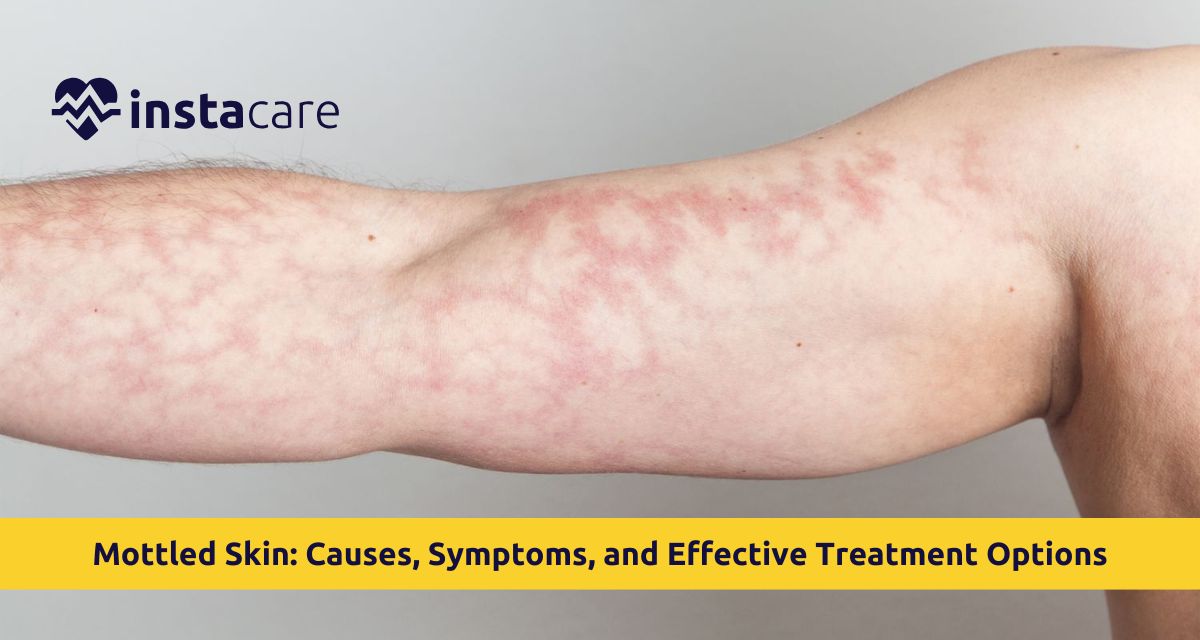What Is Mottled Skin?
Mottled skin means the surface gets uneven color, showing splotches that look like a web or jagged design. Sometimes these zones turn purplish, others go red or take on a washed-out hue. Called livedo reticularis by doctors if it forms a delicate meshed appearance, this happens when tiny blood channels under the dermis shift their behavior.
Mottled skin in adults usually shows up on the arms, legs, or torso - but sometimes pops up elsewhere too. Blood moving poorly through tiny vessels causes the patchy look, since circulation slows down or gets shaky. In babies, this kind of skin change tends to fade fast and isn't a big deal; mottled skin in newborns is often temporary. Yet when adults keep showing these patches, something deeper - like blood flow trouble or body-wide problems - might be going on.
Causes of Mottled Skin
Figuring out why skin gets patchy can show if it's just passing or needs a doctor's look. Typical causes of mottled skin are:
Cold Exposure
When it's chilly outside, spotty skin can pop up because blood vessels tighten - this fades naturally once things heat back up again. Cold mottled skin is a common temporary response.
Poor Circulation
This problem often leads to trouble. If veins have a hard time pushing enough blood around, you might notice blotchy patches showing up - especially on lower limbs, since they're farther from the heart. Poor circulation skin discoloration manifests as these patchy areas.
Shock or Critical Illness
When someone's really sick or in shock, blood gets pulled toward key organs - so the skin might show patchy spots. After dying, blotchy skin appears because blood stops moving altogether. Mottled skin after death occurs due to ceased circulation.
Autoimmune Disorders
Lupus might lead to livedo reticularis because it makes the body attack its own blood vessels. However, not everyone with such conditions shows this skin change.
Vascular Conditions
Vascular issues - like inflammation of arteries or hardening of the veins - might cause lasting patchy skin, since circulation gets disrupted over time. Skin mottling and circulation issues are closely linked.
Medications
Some medicines can lead to blotchy skin - especially ones that change how blood moves or make blood vessels tighten up.
Aging
As people get older, their skin can start showing blotchy patches - this happens because the skin gets thinner or blood vessels become less strong.
Symptoms to Look Out For
Mottled skin symptoms change based on what's behind them - yet you'll often notice things like:
- Spotty, uneven color changes showing webbed or lacy designs
- Purple, reddish shades - or even blue-ish hints - show up in impacted spots (purple blotchy skin)
- Cool feeling in patchy areas
- Skin turns pale under pressure, yet quickly regains its patchy look once released
- Discomfort or loss of feeling might show up if things get bad
- Shifts in how the skin feels or its warmth
One key thing to remember: mottled skin isn't the same as a rash. Unlike rashes - often red, bumpy, and itchy - mottled areas lie flat with uneven color but no swelling or roughness. Instead of irritation, it's more about blotchy tone shifts across the skin's surface. Understanding the difference between mottled skin and rash helps with proper identification.
Diagnosis of Mottled Skin
Doctors check mottled skin by looking at it closely while also asking about past health issues. Yet they study how the spots are arranged, where they show up, along with how long they've been there. Tests might follow - like blood work or imaging - to get clearer answers:
- Checking the parts of the body that feel pain or show symptoms
- Blood work to spot hidden health issues
- Blood flow checks using vessel scans
- Skin sample now and then
- Checking for signs the body's defense system is attacking itself
Treatment and Management of Mottled Skin
Treatment aims to tackle what's really causing it instead of just how the skin looks. Options for mottled skin treatment might involve:
Improving Circulation
Getting your blood moving can come from staying active, shifting positions often, or keeping your body cozy - these all chip in. For folks struggling with poor flow in the legs, squeeze socks might make a difference. This is especially helpful for mottled skin on legs.
Managing Underlying Conditions
Taking care of root health issues - like immune system problems or blood flow troubles - can make the skin look better over time because fixing what's underneath usually shows on the surface.
Medications
Medicines like vasodilators can widen arteries; on the flip side, blood thinners might stop clots when needed.
Lifestyle Adjustments
Lifestyle changes help blood vessels - stay out of cold, stop smoking, while keeping blood pressure steady.
Home Remedies and Prevention of Mottled Skin
Some ways at home might stop or reduce blotchiness:
- Wear suitable clothes so your hands and feet stay cozy
- Drink water so your blood flows well
- Work out often so your circulation gets a boost
- Wear looser outfits so blood can flow better
- Gently rub sore spots to get the blood moving
- Eat well - fill your meals with omega-3 fats
- Raise your legs up while you're off your feet - this helps blood flow back better
When to See a Doctor for Mottled Skin
Get help from a healthcare provider if spotting signs that mean when to see a doctor for mottled skin turns critical:
- Mottling shows up outta nowhere, even when it's not chilly
- Along with discomfort, puffiness, or lack of strength
- Persists even when things heat up
- Happens when there's a high temperature, mixed-up thinking, yet trouble taking deep breaths
- Shows up together with other worrying signs
- Hits babies hard, lasting way past those early weeks
Conclusion
Mottled skin in adults can mean anything from a passing odd look to signs of deeper health problems. When your skin gets patchy from being chilly, it often fades without fuss - yet if the blotchiness sticks around, getting checked makes sense. Figuring out what's behind the spotting, noticing other clues your body gives, plus acting at the right time helps you stay on track. Should your skin keep mottling for no clear reason - or come with blood flow troubles - it's smart to reach out to a doctor for answers and next steps.
Please book an appointment with the
best Dermatologist in Lahore, Karachi, Islamabad, and all major cities of Pakistan through
InstaCare, or call our helpline at 03171777509 to find a verified doctor for your disease.

